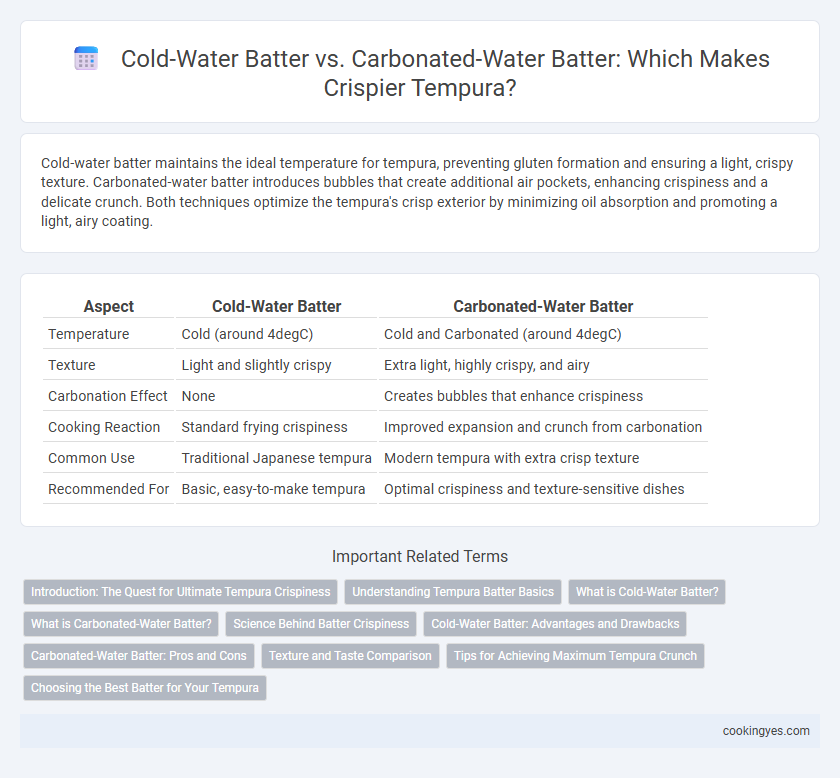Cold-water batter maintains the ideal temperature for tempura, preventing gluten formation and ensuring a light, crispy texture. Carbonated-water batter introduces bubbles that create additional air pockets, enhancing crispiness and a delicate crunch. Both techniques optimize the tempura's crisp exterior by minimizing oil absorption and promoting a light, airy coating.
Table of Comparison
| Aspect | Cold-Water Batter | Carbonated-Water Batter |
|---|---|---|
| Temperature | Cold (around 4degC) | Cold and Carbonated (around 4degC) |
| Texture | Light and slightly crispy | Extra light, highly crispy, and airy |
| Carbonation Effect | None | Creates bubbles that enhance crispiness |
| Cooking Reaction | Standard frying crispiness | Improved expansion and crunch from carbonation |
| Common Use | Traditional Japanese tempura | Modern tempura with extra crisp texture |
| Recommended For | Basic, easy-to-make tempura | Optimal crispiness and texture-sensitive dishes |
Introduction: The Quest for Ultimate Tempura Crispiness
Cold-water batter maintains a lower temperature that prevents gluten formation, resulting in a lighter, crispier tempura texture. Carbonated-water batter introduces bubbles that expand during frying, creating an airy, crunchy crust with enhanced crispiness. Comparing these batters reveals distinct effects on tempura's delicate crunch, with cold water promoting tenderness and carbonation maximizing crispness.
Understanding Tempura Batter Basics
Cold-water batter is essential for creating a light and crispy tempura texture by preventing gluten development in the flour. Using carbonated water introduces bubbles that enhance aeration, resulting in a more delicate and crunchy coating. Both batter types emphasize maintaining low temperatures to achieve the signature tempura crispiness by minimizing oil absorption.
What is Cold-Water Batter?
Cold-water batter for tempura is made using chilled water, which slows gluten development and preserves a light, airy texture in the coating. This batter typically includes cold water, flour, and sometimes egg, resulting in a delicate crispiness that contrasts with the food inside. Using ice-cold water is crucial for preventing batter from becoming dense, ensuring the tempura remains crisp even after frying.
What is Carbonated-Water Batter?
Carbonated-water batter for tempura incorporates sparkling water, which introduces tiny bubbles that help create a lighter and crisper texture compared to traditional cold-water batter. The carbonation aerates the batter, preventing gluten formation and producing a delicate, flaky crust that enhances the overall crunchiness of the tempura. This method is favored by chefs aiming for a more airy and crisp tempura coating without adding extra weight or oiliness.
Science Behind Batter Crispiness
Cold-water batter preserves gluten structure, producing a light, airy texture essential for tempura crispiness by minimizing gluten development. Carbonated-water batter introduces bubbles of carbon dioxide that expand during frying, creating a delicate, crunchy crust through increased aeration. Both batters optimize heat transfer and moisture evaporation differently, affecting the final crispiness of tempura.
Cold-Water Batter: Advantages and Drawbacks
Cold-water batter for tempura offers a light and delicate texture, enhancing crispiness due to its low protein content, which minimizes gluten formation. This batter maintains a stable temperature during frying, preventing oil absorption and resulting in a less greasy, crisp finish. However, cold-water batter can be less resilient, sometimes leading to a fragile crust that may flake off easily during handling.
Carbonated-Water Batter: Pros and Cons
Carbonated-water batter enhances tempura crispiness by incorporating tiny bubbles that create a lighter, airier coating, which fries to a delicate, crunchy texture. This batter often produces a more textured and visually appealing crust compared to cold-water batter but can be less forgiving, requiring precise temperature control to avoid overcooking or sogginess. While carbonated-water batter excels in crispiness and mouthfeel, it may be slightly more challenging for beginners due to its instability and sensitivity during frying.
Texture and Taste Comparison
Cold-water batter for tempura produces a delicate, light texture with a mild taste that emphasizes the natural flavor of the ingredients. Carbonated-water batter introduces a slightly bubbly, crispy crust that adds an airy crunch and a subtle tang, enhancing overall flavor complexity. Texture-wise, cold-water batter yields a finer, less brittle crispness, while carbonated-water batter provides a more pronounced crunch and a dynamic mouthfeel.
Tips for Achieving Maximum Tempura Crunch
Using ice-cold water in tempura batter slows gluten formation, resulting in a lighter, crispier texture that resists oil absorption. Carbonated water introduces bubbles that create more air pockets, enhancing crispiness and lightness of the tempura coating. For maximum crunch, keep batter ingredients cold, mix minimally, and fry immediately at high heat around 180degC to prevent sogginess.
Choosing the Best Batter for Your Tempura
Cold-water batter for tempura maintains a lower temperature, minimizing gluten formation and resulting in a light, delicate crispiness ideal for seafood and vegetables. Carbonated-water batter introduces bubbles that create an aerated, airy texture, enhancing crunchiness and making it a popular choice for thicker or mixed tempura ingredients. Selecting the best batter depends on the desired crispiness and texture, with cold water offering subtle crispness and carbonated water delivering a more pronounced, crunchy finish.
Cold-water batter vs Carbonated-water batter for Tempura crispiness Infographic

 cookingyes.com
cookingyes.com